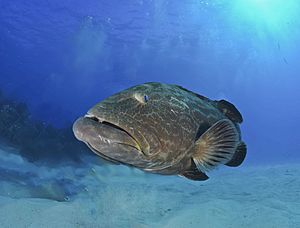Black grouper facts for kids
Quick facts for kids Black grouper |
|
|---|---|
 |
|
| Conservation status | |
| Scientific classification | |
| Synonyms | |
|
The Black Grouper, also called the black rockfish or marbled rockfish, is a type of ray-finned fish that lives in the ocean. It belongs to the grouper family, which also includes sea basses. You can find this fish in the western Atlantic Ocean, stretching from the northeastern United States all the way down to Brazil.
Sometimes, other fish are also called "black grouper." These include the similar gag grouper and the misty grouper. The Warsaw grouper, which is a different species, is also sometimes confused with it.
Contents
About the Black Grouper
What Does It Look Like?
The Black Grouper has a long, somewhat flat body. Its body is about 3.3 to 3.5 times longer than it is deep. The edge of its gill cover is smooth and rounded.
It has two main fins on its back: one with 11 sharp spines and another with 15-17 soft rays. Its tail fin can look straight or slightly curved inward.
The fish is usually an olive-grey color. It has dark blotches and cool brassy, hexagon-shaped spots on its head and sides. Its front fins are dark brown, fading to orange near the edges. The soft part of its back fin, its bottom fin, and the front edge of its belly fins all have a dark border.
This fish can grow quite large! The biggest Black Grouper ever recorded was about 150 centimetres (59 in) long. However, they are more commonly around 70 centimetres (28 in) long. The heaviest one found weighed about 100 kilograms (220 lb).
Where Do Black Groupers Live?
Black Groupers live in the western part of the Atlantic Ocean. Their home range goes from Cape Canaveral in Florida and Bermuda south to the Bahamas. They are also found in the Gulf of Mexico, as far north as Alabama and along the coast from southern Texas to Mexico and Cuba.
You can find them all over the Caribbean Sea. They also live along the coast of South America, reaching down to Santa Catarina in Brazil. They even live near the Brazilian islands of Trinidade and Fernando de Noronha. Young Black Groupers have been seen as far north as Massachusetts in the United States, but they are usually just visiting those colder waters.
Their Home and Daily Life
Black Groupers prefer to live over rocky areas and coral reefs. They are usually found in waters about 10 to 30 metres (33 to 98 ft) deep. However, in the eastern Gulf of Mexico, they often live in deeper waters, more than 30 metres (98 ft) deep.
These fish usually live alone. Adult Black Groupers mostly eat other fish, like grunts, snapper, and herrings. Younger groupers prefer to eat small crustaceans, like crabs and shrimp.
Sometimes, Black Groupers gather together in groups to feed. This happens off the coast of Brazil when other fish they like to eat are also gathering to lay their eggs.
How They Reproduce
Black Groupers are special because they are "protogynous hermaphrodites." This means they are born female and later change into males! They also gather in groups to lay their eggs, which has been seen in the Gulf of Mexico and the Caribbean Sea.
Female Black Groupers become ready to have babies when they are about 5 years old and around 82.6 centimetres (32.5 in) long. They change into males when they are about 15 years old and have grown to an average length of 121.4 centimetres (47.8 in).
Who Are Their Predators and What About Parasites?
Bigger ocean animals sometimes hunt Black Groupers. These predators include the sandbar shark and the great hammerhead shark. They might also be hunted by great barracuda and moray eels.
Like many animals, Black Groupers can have parasites. Some parasites live inside their stomach and intestines (these are called endoparasites). Others live on their skin (these are called ectoparasites).
History and Use
Naming the Black Grouper
The Black Grouper was first officially described in 1860 by a Cuban zoologist named Felipe Poey. He named it Serranus bonaci. The first fish he studied to describe the species came from Cuba.
How People Use Them
Black Groupers are a popular and tasty fish to eat. People catch them both for selling in markets and for fun as a sport fish.
Conservation Status
The Black Grouper is listed as "Near Threatened" by the IUCN Red List. This means that while they are not in immediate danger, their numbers could decrease if too many are caught. They are vulnerable because they don't reproduce very quickly.
See also
 In Spanish: Microperca bonacci para niños
In Spanish: Microperca bonacci para niños


